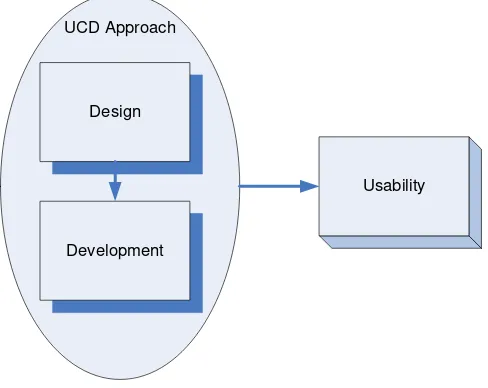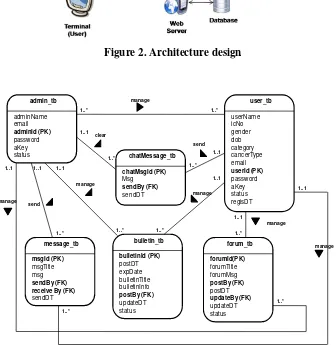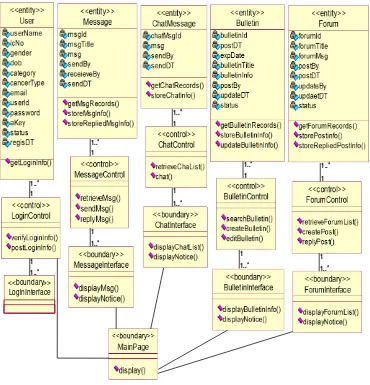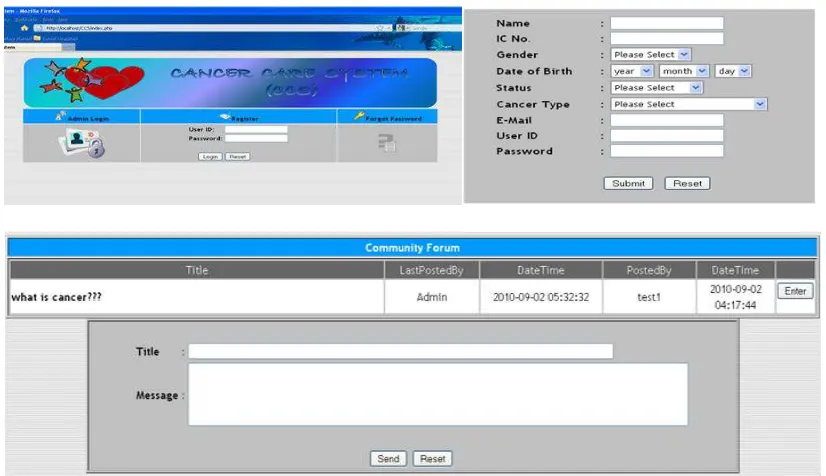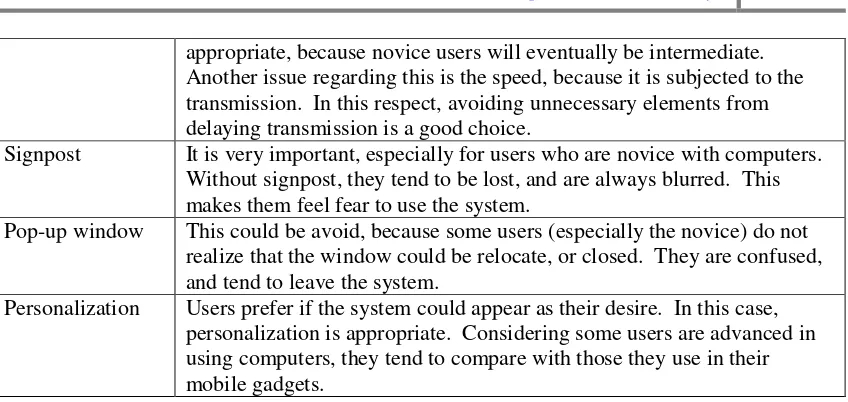469
NECESSITY AND USABILITY ISSUES FOR CANCER CARE
SYSTEM
Ariffin, A.M.
1and Juhriansyah, D.
21
Universiti Utara Malaysia, Malaysia, am.ariffin@uum.edu.my 2
IAIN Antasari, Banjarmasin, Indonesia, j.dalle@ymail.com
ABSTRACT. This paper discusses on usability issues pertaining to an interactive system that supports communication among cancer community, called cancer care system (CCS). The initiative was accelerated after an investigation involving patients, caregivers, and medical practitioners found that their communication needs supports from a tool that enables them to participate privately. The CCS was designed and developed using user-centered design (UCD) approach. Most design and development activities involve observation and user participation; hence this study collects rich data on usability issues sensitive to the users. In the end, this paper outlines the usability issues to be addressed when designing such interactive communication support.
Keywords: cancer care, usability, UCD, CCS
INTRODUCTION
An initial study carried out at the beginning of this study reveals that the main limitation faced by most cancer patients is mismatching. This happens in which a particular person who wants to interact with others is not able to find any proper channel. Also, experienced patients who are willing to help new patients reduce the feelings of uncertainty and stress that are affected by their illness are not supported. Besides that, this also leads to physical isolation, which means patients and their caregivers are isolated physically from each other for a significant period. In regards to this, cancer patients must follow a series of chemotherapy or radiotherapy from time to time in order to get the chance to recover from illness. With that, they spend most of their time for that purpose in medical center and this gives them a limited face-to-face access with other people in their social activities.
Meanwhile, from parents‘ views, they should communicate with medical practitioners
very frequently, especially during early detection. The communication is necessary for many reasons such as to get advice, to address any symptom, and to express any anxiety. Besides, during the treatment (which takes at least two years) also, they need to communicate with the
medical practitioners to follow up the patient‘s condition and to gather information regarding
the diagnostics and treatments of the disease, including the following appointments. In current practice, most communications are done through phone calls or face-to-face. This has been very time-consuming and costly. On top of that, in most of the times, medical practitioners fail to contact the patients because of phone technical errors (such as out of battery, switched-off, and lost).
470 communication channel could ensure that information could always reach the receivers. This further lets the information be updated at any appropriate time.
Hence, a social network system specially designed for the cancer community is viable for supporting the collaborative ubiquitous communication, which is proposed to be referred to as cancer care system (CCS). It is said viable because the technology advancements support the implementation. In fact the use of computers is very pervasive among the cancer community.
Based on the problems discussed in the previous paragraphs, this paper tends to answer a significant question; what makes CCS usable? This implies that usability issues need to be specially tailored for the CCS. It is significant because the users vary; medical practitioners, parents, children; in terms of age, computer literacy level, educational background, and motivation level.
METHOD
Various activities involved in this study (Figure 1). It started with designing and developing the prototype of CCS. Then, the prototype was used to gather feedbacks on the usability issues.
UCD Approach
Design
Development
Usability
Figure 1. Summary of techniques
471 This paper does not intend to discuss the design and development parts extensively. In contrast, the usability aspects are the main focus. However, the design artifacts as well as the CCS itself are provided illustratively in Figures 2 through 5.
Figure 2. Architecture design
Figure 3. Database design
USER FEEDBACK
Having developed the CCS, this study let users to experience it. During the experiencing session, their interactions were observed. The following paragraphs discuss the findings.
472 that everyone in the system (when fully implemented) will always access to it because they have similar expectations. Using mobile phones for messaging and calling may help but it is rather expensive compared to the CCS, which is free, and able to support public view (among the registered users) (Jing, Yanchun, Guangyan, & Jinli, 2012).
Similarly, parents find that the CCS is really useful in communicating with the medical practitioners. Among the crucial information they need from the medical practitioners
include appointment details (date, time, and reason), and their children‘s clinical test (there
are many tests involved such as blood, urine, and x-ray) results. In current situation, they have to always call the medication providers to check the status, which cost them a lot. In many cases, the person in-charge of the appropriate records is not available. In this case, they have to repeat the call in different times. Hence, the idea of a private system like CCS reduces the cost of communication significantly.
Figure 4. Class diagram
On top of that, they are always worried about their children‘s status after any experiment
or treatment is done. Hence, they want to be notified about the results quickly. In this case, the system supports the information to be notified at any time, for access at any time. This is different than using phone calls significantly, which in most cases human beings would not make phone call at late night.
1..* 1
1 1..*
1..* 1
1 1..*
1..* 1
1 1..*
1..* 1
LoginInterface <<boundary>>
1 1..*
1..* 1
473 Meanwhile, the medical practitioners were found more excited than the parents. One of their responsibilities is to notify the parents regarding treatments including appointments, and test results. In current situation, they do it through phone calls. There have been many cases, in which parents do not answer their phone calls, and the calls are answered by other persons who do not get the messages through the parents (such as children), and the phone numbers could not be reached and unanswered. These make the communication not smooth. Hence, the CCS is able to support the limitations in communication using phone calls. They could write the message even at night, so that the parents could access it at night also or early morning, without guessing about the convenience. On top of that, this reduces the cost for communication in a long run significantly.
Figure 5. Sample of pages in CCS
Usability
Besides users‘ acceptance on the CCS, this study analyzes the usability issues for such
system, in which the users vary demographically (as emphasized in early part of this paper). Through observations while the users were experiencing the CCS, it was found that some users face difficulties. While detailed discussions are not possibly addressed for discussion in this paper, a summarized version is provided in Table 1.
Table 1. Usability issues for CCS
Usability Aspect Descriptions on the applicability
Terminology The terminology should be very simple, because part of the users are children and those with low academic background
Navigation style Some users are good at operating computers; in fact some are very familiar with touch screen. However, there are users who have never experienced touch screen. In this case, being moderate is the best. Hence, the navigation style should be minimal, suitable for mouse and keyboard input devices.
Menu Avoid ‗depth and breadth‘ menu hierarchy.
474 appropriate, because novice users will eventually be intermediate. Another issue regarding this is the speed, because it is subjected to the transmission. In this respect, avoiding unnecessary elements from delaying transmission is a good choice.
Signpost It is very important, especially for users who are novice with computers. Without signpost, they tend to be lost, and are always blurred. This makes them feel fear to use the system.
Pop-up window This could be avoid, because some users (especially the novice) do not realize that the window could be relocate, or closed. They are confused, and tend to leave the system.
Personalization Users prefer if the system could appear as their desire. In this case, personalization is appropriate. Considering some users are advanced in using computers, they tend to compare with those they use in their mobile gadgets.
Table 1 lists a number of usability issues that this study gathered from the users. While usability principles are a lot (Preece, Rogers, & Sharp, 2007), this study collects only those
based on users‘ experience with the CCS.
DISCUSSION
This study discovers some usability issues for a system to be used by users with varied characteristics. Obviously, they represent novice, intermediate, and expert users (Dix, Finlay, Abowd, & Beale, 2004). While entertaining the experts will let the novice upset, entertaining novice only will make experts bored (Wright, McCarthy, & Marsh, 2000). Hence, this study recommends that such system should be designed to accommodate the needs of the intermediate users.
REFERENCES
Ariffin, A.M. & Nor Laily, H. (2011). Design and Development of a Ubiquitous Cancer Care System: A Collaborative Communication among Cancer Community. In Informatics Engineering and Information Science. Vol 254. 115-134. ISBN: 978-3-642-25482-6 (Print) 978-3-642-25483-3 (Online).
Dix, A., Finlay, J., Abowd, G. D., & Beale, R. (2004). Human-computer Interaction 3rd edition.
Pearson Education Limited. England
Jesse, J. G. (2000). The elements of user experience. User-centered design for the web. USA: New Riders.
Jing, H., Yanchun, Z., Guangyan, H., & Jinli, C. (2012). A smart web service based on the context of things. Transactions on Internet Technology. 11(3). 13-23.
Preece, J., Rogers, Y., & Sharp, H. (2007). Interaction Design: beyond human-computer interaction 2nd edition. John Wiley& Sons, Ltd. England
Taylor, C. & Dajani, L. (2008). The future of homecare systems in the context of the ubiquitous web and its related mobile technologies. In Proceedings of the 1st International Conference on Pervasive Technologies Related to Assistive Environments. ACM.
